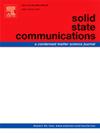Metal–insulator transition in the La1−xYxNiO3 series studied using the GGA + U method
IF 2.1
4区 物理与天体物理
Q3 PHYSICS, CONDENSED MATTER
引用次数: 0
Abstract
We studied the changes in the electronic structure of LaYNiO between x = 0.00 and 0.25. The band structure calculations were carried out using the GGA + U method with U = 1.5 eV. The calculation of LaY0.25NiO was performed using the supercell approach. The parent LaNiO compound is a paramagnetic metal with a rhombohedral structure. The doped La0.75Y0.25NiO material is an antiferromagnetic insulator with a monoclinic structure, and present a distinct charge disproportionation at the inequivalent Ni sites. This study predicts that a metal–insulator transition is already realized in the LaYNiO series at x=0.25.

采用GGA + U方法研究了La1−xYxNiO3系列的金属-绝缘子转变
我们研究了La1−xYxNiO3在x = 0.00和0.25之间的电子结构变化。采用U = 1.5 eV的GGA + U法进行能带结构计算。La0.75Y0.25NiO3的计算采用超级单体法。母体LaNiO3化合物是一种具有菱形结构的顺磁性金属。掺杂的La0.75Y0.25NiO3材料是一种单斜结构的反铁磁绝缘体,在不相等的Ni位点存在明显的电荷歧化现象。该研究预测,在x=0.25时,La1−xYxNiO3系列中已经实现了金属-绝缘体转变。
本文章由计算机程序翻译,如有差异,请以英文原文为准。
求助全文
约1分钟内获得全文
求助全文
来源期刊

Solid State Communications
物理-物理:凝聚态物理
CiteScore
3.40
自引率
4.80%
发文量
287
审稿时长
51 days
期刊介绍:
Solid State Communications is an international medium for the publication of short communications and original research articles on significant developments in condensed matter science, giving scientists immediate access to important, recently completed work. The journal publishes original experimental and theoretical research on the physical and chemical properties of solids and other condensed systems and also on their preparation. The submission of manuscripts reporting research on the basic physics of materials science and devices, as well as of state-of-the-art microstructures and nanostructures, is encouraged.
A coherent quantitative treatment emphasizing new physics is expected rather than a simple accumulation of experimental data. Consistent with these aims, the short communications should be kept concise and short, usually not longer than six printed pages. The number of figures and tables should also be kept to a minimum. Solid State Communications now also welcomes original research articles without length restrictions.
The Fast-Track section of Solid State Communications is the venue for very rapid publication of short communications on significant developments in condensed matter science. The goal is to offer the broad condensed matter community quick and immediate access to publish recently completed papers in research areas that are rapidly evolving and in which there are developments with great potential impact.
 求助内容:
求助内容: 应助结果提醒方式:
应助结果提醒方式:


